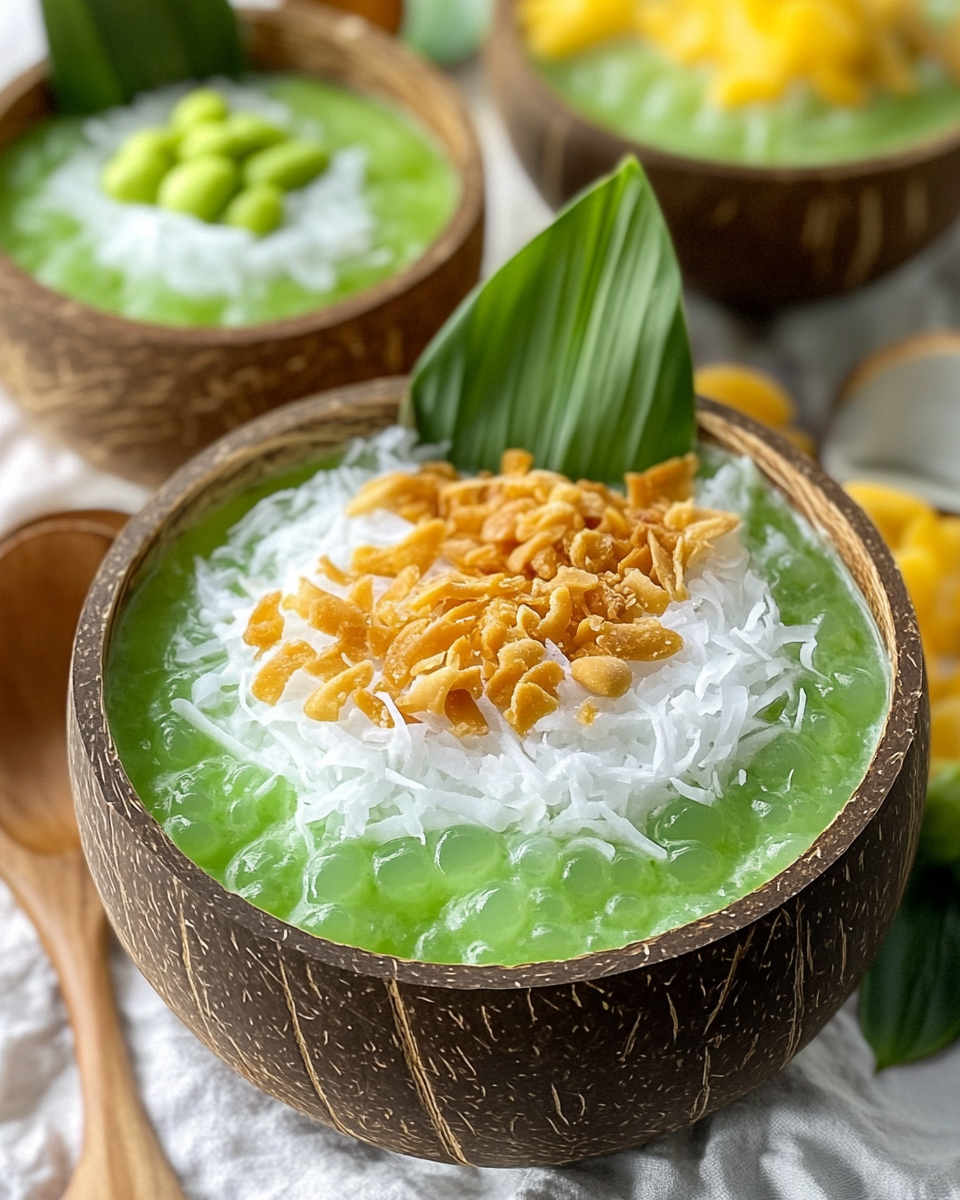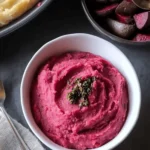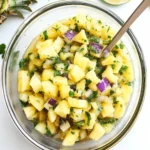This Chilled Cendol Coconut Bowl is a refreshing, sweet dessert that combines the traditional Southeast Asian cendol with coconut milk for a creamy, satisfying treat. Served cold, it’s perfect for hot days or as a unique after-meal delight.
FULL RECIPE
Ingredients
- 1 cup green cendol (jelly noodles)
- 1 cup coconut milk
- 1/4 cup palm sugar syrup (or substitute with brown sugar syrup)
- 1/2 cup crushed ice
- 2 tablespoons sweetened condensed milk
- 1 tablespoon cooked mung beans (optional)
- Fresh pandan leaves for garnish (optional)
Directions
- Prepare the cendol by either using pre-made cendol or making your own from green rice flour and pandan juice.
- In a serving bowl, layer the bottom with a generous portion of cendol.
- Pour in the coconut milk, ensuring the cendol is covered.
- Add a few tablespoons of palm sugar syrup, adjusting to taste for sweetness.
- Stir in sweetened condensed milk for an added creamy texture.
- Optionally, sprinkle mung beans over the top for an extra layer of flavor.
- Add crushed ice to the mixture to chill the dessert.
- Garnish with fresh pandan leaves for an aromatic touch.
- Serve immediately and enjoy the chilled, sweet goodness.
Nutritional Information
- Calories: Approximately 250-300 per serving
- Fat: 15-18g
- Carbohydrates: 35-40g
- Protein: 2g
- Sugar: 25-30g
- Fiber: 2g
- Sodium: 20-30mg
History and Origins of Cendol
Cendol is a beloved dessert originating in Southeast Asia, particularly in countries like Malaysia, Indonesia, Singapore, and Thailand. This sweet, refreshing treat has deep cultural roots and dates back several centuries. The dish consists of green rice flour noodles, traditionally colored with pandan juice, served in a chilled mixture of shaved ice, sweet syrups, and coconut milk. Over time, cendol has evolved, but it remains an iconic dessert that reflects the flavors and culinary traditions of the region.
The Evolution of Cendol in Modern Times
Though cendol’s basic ingredients have remained unchanged, its presentation and variations have evolved. Today, you’ll find cendol served with creative toppings, such as red beans, durian, or even fresh fruit. These modern twists reflect the region’s openness to experimenting with new flavors while maintaining the essence of the classic dessert. Whether in a street stall or a high-end restaurant, cendol remains a refreshing and satisfying treat.
Coconut Milk: A Key Ingredient in Cendol
Coconut milk is a star ingredient in many Southeast Asian desserts, and in cendol, it’s what gives the dish its signature richness. Derived from the flesh of mature coconuts, this creamy milk adds a natural sweetness and texture that blends beautifully with the other elements of the dessert. The richness of coconut milk enhances the chewy cendol noodles, making each bite smooth and indulgent.
The Role of Palm Sugar Syrup
Palm sugar syrup is another essential ingredient in cendol. This syrup, made from the sap of sugar palm trees, adds a rich, caramel-like sweetness that sets cendol apart from other desserts. Unlike white sugar, palm sugar has a deeper flavor profile, giving cendol its characteristic taste. Its earthy sweetness balances the richness of the coconut milk and the ice, creating a delightful flavor harmony.
Cultural Significance of Cendol in Southeast Asia
In Southeast Asia, cendol is more than just a dessert—it’s a cultural tradition. The dish is enjoyed during festivals, family gatherings, and street food excursions. Each country in the region has its own version of cendol, but they all share a common love for the combination of chewy noodles, sweet syrup, and creamy coconut milk. Cendol holds nostalgic value for many, reminding them of shared moments with loved ones.
Different Variations of Cendol Around the World
Although the classic cendol is widely enjoyed across Southeast Asia, the dish has inspired many regional variations. In Malaysia and Singapore, you might find cendol topped with red beans, durian, or sweet corn. In Indonesia, it’s often paired with fresh tropical fruits. Even in Thailand, cendol has made its mark with local twists like the addition of fresh herbs. These regional adaptations highlight the dish’s versatility and universal appeal.
The Growing Popularity of Cendol Worldwide
In recent years, cendol has garnered attention from food enthusiasts and chefs around the world. As more people explore Southeast Asian cuisine, cendol is becoming a favorite treat in international food markets. From street food stalls to upscale restaurants, cendol is being embraced for its unique flavors and textures. Its growing popularity speaks to the increasing global interest in diverse, flavorful desserts.
The Nutritional Benefits of Coconut Milk
Coconut milk is not only delicious but also packed with nutrients. It contains medium-chain triglycerides (MCTs), which can support energy production and fat metabolism. Additionally, coconut milk is rich in iron, magnesium, and potassium, essential minerals for maintaining healthy body functions. However, it’s important to enjoy coconut milk in moderation, as it’s high in calories and fat.
How Cendol Can Be Modified for Dietary Preferences
Cendol can easily be adapted to accommodate various dietary needs. For those following a vegan or dairy-free lifestyle, simply substitute coconut cream or almond milk for dairy ingredients. If you’re gluten-free, use rice flour noodles instead of wheat-based ones. You can also reduce the sugar content by opting for natural sweeteners like stevia, making this dessert suitable for those managing their sugar intake.
The Role of Mung Beans in Cendol
Mung beans are sometimes included in cendol for an added texture and subtle sweetness. These small green beans are common in Southeast Asian desserts and are known for their soft, creamy texture when cooked. They provide a mild, pleasant flavor that pairs well with the coconut milk and palm sugar syrup. Mung beans also contribute protein and fiber, making the dessert slightly more filling and nutritious.
How to Make Cendol at Home
Making cendol at home can be a fun and rewarding experience. While the green noodles might seem tricky to prepare, they’re made from rice flour and pandan juice, which can be easily sourced from Asian grocery stores. The process of assembling cendol is straightforward: mix the noodles with coconut milk, add syrup, and top with ice and optional ingredients. For those pressed for time, pre-made cendol noodles are available, making it even easier to enjoy this dessert at home.
Cendol as a Refreshing Summer Treat
Cendol is particularly refreshing during the hot summer months. Its chilled coconut milk base, combined with the chewy noodles and sweet syrup, makes it an ideal dessert to beat the heat. Whether enjoyed as an afternoon snack or a sweet treat after a meal, cendol’s cool, creamy texture is a perfect way to stay refreshed during sweltering days.
The Art of Plating Cendol
While flavor is the focus of any great dessert, presentation can also elevate the overall experience. Cendol is traditionally served in a bowl or glass, but you can get creative with the plating. Adding vibrant toppings like fresh tropical fruits, mint leaves, or edible flowers can make the dish more visually appealing. A well-plated cendol can transform this simple dessert into an eye-catching centerpiece.
Pairing Cendol with Other Southeast Asian Desserts
Cendol pairs wonderfully with other popular Southeast Asian sweets. It complements crispy treats like fried bananas (pisang goreng) or soft, sweet rice cakes (kueh). The contrast of textures, from the chewy cendol to the crunchy or creamy side dishes, creates a satisfying dessert experience. Cendol can also be served with tropical fruits like mango, papaya, or lychee, enhancing its fruity, refreshing qualities.
Exploring the Different Types of Palm Sugar
Not all palm sugars are the same, and the variety you choose can influence the flavor of your cendol. There are light and dark versions of palm sugar, each with varying degrees of sweetness and flavor depth. Dark palm sugar, with its stronger caramel-like notes, provides a richer flavor, while lighter versions have a more subtle sweetness. Experimenting with different types of palm sugar can yield a variety of unique flavors for your cendol.
The Importance of Fresh Ingredients in Cendol
To make the best cendol, fresh ingredients are essential. Using fresh coconut milk, pandan leaves, and homemade syrup ensures the dish tastes authentic and rich. While canned coconut milk is convenient, fresh coconut milk has a creamier texture and more vibrant flavor. Similarly, freshly prepared palm sugar syrup will bring out the best flavor, offering a sweeter and more aromatic experience.
Cendol as a Social Dessert
Cendol is often enjoyed as a shared experience. Whether bought from a street vendor or prepared at home, it’s common to enjoy this dessert in the company of friends and family. In many Southeast Asian cultures, food is a communal activity, and cendol embodies that spirit. Sharing a bowl of cendol with others fosters a sense of connection, making it an even more enjoyable experience.
Health Considerations and Moderation
While cendol is undeniably delicious, it’s important to enjoy it in moderation. The combination of sweet syrups and coconut milk can make this dessert high in sugar and calories. For those looking to make a healthier version, you can reduce the amount of syrup or use lower-calorie alternatives. It’s important to remember that cendol is meant to be an occasional indulgence rather than an everyday treat.
The Versatility of Cendol as a Dessert Base
Cendol can be used as the base for many other creative desserts. You can layer it with fresh fruits, top it with ice cream, or even blend it into a refreshing milkshake. Its chewy noodles and creamy coconut milk make it an excellent starting point for exploring new dessert combinations. The adaptability of cendol makes it a fun and versatile dish for those who love experimenting in the kitchen.
Advertisement
The Fun of Customizing Your Cendol
One of the best things about cendol is its flexibility. You can customize the dessert to suit your personal taste or dietary preferences. For a richer, creamier version, add extra coconut milk or sweetened condensed milk. If you prefer a lighter dessert, skip the syrup and top the cendol with fresh tropical fruits. The options are endless, and creating a personalized version of cendol can be a fun culinary adventure.
Conclusion
In conclusion, the Chilled Cendol Coconut Bowl is a refreshing, delicious, and versatile dessert that showcases the unique flavors of Southeast Asia. Its combination of chewy cendol noodles, creamy coconut milk, and sweet palm sugar syrup creates a perfect balance of textures and flavors. Whether enjoyed in its traditional form or with modern twists, cendol remains a beloved dessert that brings people together and offers a delightful taste of Southeast Asia. Its growing popularity worldwide is a testament to its enduring appeal.






